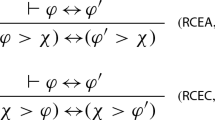Abstract
In Counterfactuals David Lewis noticed that definite descriptions and conditionals display the same kind of non-monotonic behavior. We take his observation literally and suggest that if-clauses are, quite simply, definite descriptions of possible worlds [related ideas are developed in M. Bittner (2001) Proceedings from SALT XI, CLC, Cornell University, Ithaca, pp. 36–55]. We depart from Lewis,s analysis, however, in claiming that if-clauses, like Strawsonian definite descriptions, refer. We develop our analysis by drawing both on Stalnaker,s Selection Function theory of conditionals and on von Heusinger,s Choice Function theory of definiteness, and by generalizing their analyses to plural Choice/Selection Functions. Finally, we explore some consequences of this referential approach: being definites, if-clauses can be topicalized; the word then can be analyzed as a pronoun that doubles the referential term; the syntactician,s Binding Theory constrains possible anaphoric relations between the if-clause and the word then; and general systems of referential classification can be applied to situate the denotation of the descriptive term, yielding a distinction between indicative, subjunctive and ‘double subjunctive’ conditionals.
Similar content being viewed by others
References
Anderson A. R. (1951). A Note on Subjunctive and Counterfactual Conditionals. Analysis, 11, pp. 35-38.
Barker S. (1997) E-type pronouns, DRT, dynamic semantics and the quantifier/variable binding model. Linguistics & Philosophy, 20(2), pp. 195-228.
Bhatt R., Pancheva R. (2001) The Syntax of Conditionals, ms., University of Texas at Austin & University of Southern California.
Bittner M. (2001) Topical Referents for Individuals and Possibilities. In Hastings R. et al. (eds. ), Proceedings from SALT XI, CLC, Cornell University, Ithaca, pp. 36-55.
Chierchia G. (1989) Anaphora and Attitude De Se, In Bartsch R., Van Benthem J., van Emde Boas P. (eds. ) Semantics and Contextual Expressions, Foris, Dordorecht, pp. 1-31.
Dekker P. (2000) Coreference and Representationalism. In von Heusinger K., Egli U. Reference and Anaphoric Relations, Kluwer.
Fintel K. von (1997) Bare Plurals, Bare Conditionals, and Only. Journal of Semantics, 14 (1), pp. 1-56.
Fintel K. von (1999) NPI-Licensing, Strawson-Entailment, and Context-Dependency Journal of Semantics, 16, pp. 97-148.
Fintel K. von (2001) Counterfactuals in a Dynamic Context. In Kenstowicz, M., (ed. ), Ken Hale: A Life in Language, MIT Press Cambridge, MA, pp. 123-152.
Frank A. (1997) Context Dependence in Modal Constructions. Doctoral Dissertation, University of Stuttgart.
Geurts B. (1999) Presuppositions and Pronouns, Elsevier.
Hale K. (1976) The Adjoined Relative Clause in Australia. In Dixon R. (ed. ) Grammatical Categories in Australian Languages, Australian Institute of Aboriginal Studies, Canberra, pp. 78-105.
Harper W. L., Stalnaker R., Pearce G. (eds. ) (1981) Ifs, Reidel.
Heim I. (1991) Artikel und Definitheit. In Stechow A. v., Wunderlich D. (eds. ) Handbuch der Semantik.de Gruyter, Berlin.
Heim I. (1984) A Note on Polarity Sensitivity and Downward Entailingness. Proceedings of NELS 14, pp. 98-107.
Heim I. (1992) Presupposition Projection and the Semantics of Attitude Verbs. Journal of Semantics 9, pp. 183-221.
Heusinger K. von (1996) Salienz und Referenz (Der Epsilonoperator in der Semantik der Nominalphrase and anaphorischer Pronomen).
Heusinger K. von (2000) Reference and Salience, available online at: http://ling. uni-konstanz. de/pages/home/heusinger/publications/ftp/ap71_2. pdf.
Iatridou S. (1994) On the Contribution of Conditional Then. Natural Language Semantics, 2, pp. 171-199.
Iatridou S. (2000) The Grammatical Ingredients of Counterfactuality. Linguistic Inquiry, 31, pp. 231-270.
Ippolito M. (2003) Presuppositions and Implicatures in Counterfactuals. Natural Language Semantics, 11, pp. 145-186.
Izvorski R. (1996) The Syntax and Semantics of Correlative Proforms. In Kusumoto (ed. ), Proceedings of NELS 26.
Kratzer A. (1991) Conditionals. In von Stechow A., Wunderlich D. (eds. ) Semantik: ein internationales Handbuch der zeitgeno¨ssischen Forschung.
Lewis D. (1973) Counterfactuals, Harvard
Lewis D. (1979) Scorekeeping in a Language Game. Journal of Philosophical Logic, 8, pp. 339-359.
Lo¨ bner S. (1985) Definites. Journal of Semantics, 4, pp. 279-326.</del>
Lo¨ bner S. (1987) The Conceptual Nature of Natural Language Quantification. In Ruzsa I., Szabolcsi A. (eds. ), Proceedings of the '87 Debrecen Symposium on Logic and Language, Akade´ miai Kaido´, Budapest, pp. 81-94.
Lycan W. (2001) Real Conditionals. Oxford: Clarendon.
Matthewson L. (2001) Quantification and the Nature of Crosslinguistic Variation. Natural Language Semantics 9, pp. 145-189.
McCawley J. (1979) Presupposition and Discourse Structure. In Oh, Dinneen, (ed. ) Syntax & Semantics 11.
Nute D. (1980) Topics in Conditional Logic, Reidel
Percus O. (2000) Constraints on Some Other Variables in Syntax. Natural Language Semantics, 8(3), pp. 173-229.
Roberts C. (1989) Modal subordination and pronominal anaphora in discourse. Linguistics and Philosophy, 12, pp. 683-721.
Rooth M. (1996) Focus. In Lappin, (ed. ), Handbook of Contemporary Semantic Theory, Blackwell.
Schein B. (2001) Adverbial, descriptive reciprocals. In Hastings R., Jackson B., Zvolenszky Z., (eds. ) Proceedings of Semantics and Linguistic Theory XI.CLC Publications, Ithaca. Department of Linguistics, Cornell University. department of Linguistics, Cornell University.
Schlenker P. (1999/2000) Propositional Attitudes and Indexicality (A Cross-Categorial Approach), Doctoral Dissertation, MIT (Introduction revised, August 2000).
Schlenker P. (1999) Semantic Uniformity, hand-out of a talk given at the First International Symposium on Linguistics (LICSSOL1), Lyons, France, 1999.
Schlenker P. (2000) Towards a Null Theory of Conditionals, hand-out of a talk given at the Conference on (Preferably) Non-Lexical Semantics, Paris, May30, 2000
Schlenker P. (2001) A Referential Analysis of Conditionals. In Proceedings of the Amsterdam Colloquium.
Stalnaker R. (1968) A Theory of Conditionals. Studies in Logical Theory, American Philosophical Quaterly, Monograph: 2.
Stalnaker R. (1975) Indicative Conditionals, Philosophia 5, pp. 269-286.
Stanley J., Szabo Z. (2000) On Quantifier Domain Restriction. Mind and Language, 17.
Stechow A. von (2002) Binding by Verbs: Tense, Pronouns and Mood under Attitudes. In Lohnstein H., Trissler S. (eds. ) The Syntax and Semantics of the Left Periphery, 44.de Gruyter: Berlin.
Stechow A. von (2003) Feature Deletion under Semantic Binding: Tense, Person and Mood under Verbal Quantifiers, Proceedings of NELS 33.
Stone M. (1997) The Anaphoric Parallel between Modality and Tense, IRCS Report 97-06.
Author information
Authors and Affiliations
About this article
Cite this article
Schlenker, P. Conditionals as Definite Descriptions. Research on Language and Computation 2, 417–462 (2004). https://doi.org/10.1007/s11168-004-0908-2
Issue Date:
DOI: https://doi.org/10.1007/s11168-004-0908-2




